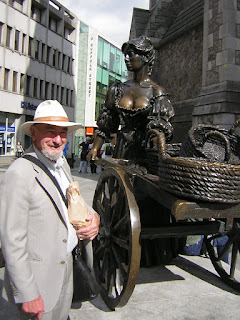 |
| Visiting Molly Malone |
Irish Eyes:
When I first visited Ireland a few years ago I explored the
west coast, after all this was often claimed to be the “real” Ireland unlike
the part within the pale. A place were people were still speaking Gaelic. Were all the
favourite Folk songs originated from, well those usually sung in Australian
seaman’s pubs and other drunken events. The names spoke volumes, Kerry, Bantry
Bay, Shannon, Limerick, Galway, endless lists of cherished memories locked away
in the heads of early Irish settlers to this Australia. Knowledge of the south
east corner of Ireland by comparison for me was scarce. After Dublin and Waterford crystal
the cupboard became bare. I still remember the trip up to Galway and the
lost weekend in Connemara were a Gaelic speaker conference was being held and I
spent the night in a pub listening dirges rather than rollicking Irish jigs I had hoped for.
Then on to Sligo to visit Yeats’ grave and the honeyed voice of a local guide
who ferreted elderly American women up to the Big House on the hill in his horse and trap.
This more recent trip was a more sedate affair’ visiting an
old friend in Wicklow and looking at the Book of Kells and Dublin in general. Naturally
there was the odd shower, but most Irish eyes seemed to be smiling despite what
appeared to be major political disagreements among many citizens. Our visit to
Trinity College to view this famed work was quite an eye opener. I had no idea
of the scale of each page, nor the more the complex patterns of both text and
decoration. Beautiful lineal control independent of its neighbour that somehow
created the impression of a line shadow. Likewise paint applied in a broken
manner so as to give the sparkle of stained glass windows. The question of
whether the painter and writer were the same monk remains debatable, but the
final work remains as one of mankind greater achievements. Walking around
Trinity grounds the visitor is struck with the diverse collection of large
outdoor sculptures. One that particularly caught my eye I believe was created
by a South American sculptor who generously donated it to the University.
The train journey to
Wicklow next day presented a more fertile countryside in marked contrast to the many
miles of the little stone plots of Western Ireland were struggling farmers in the past were
forced to collect seaweed to build up their little patch of dirt in order to
grow anything. At the time I felt the despair they must have felt.
Wicklow and the surrounds proved to be a series of small
villages, that seemed to hug the sea in defiance’s of the Atlantic Ocean. In one
part of the coast, I observed that the ocean moved in opposite direction at the
same time . Most certainly not an ideal swimming location. Looking out across
the ocean it is easy to understand why many in the 19th cent
consider this to be the edge of the world, those early Irish convicts who made
the journey to Van Diemen’s land in many
ways must have thought they were travelling from one edge to the other.
 |
| Not a good swimming spot. |
 |
| The edge of the world? |

No comments:
Post a Comment